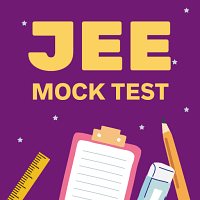JEE Exam > JEE Questions > SECTION-II (Integer Type)This Section contain...
Start Learning for Free
SECTION-II (Integer Type)
This Section contains 5 questions. The answer to each question is a single-digit integer, ranging from 0 to 9.
Enter only the numerical value in the space provided below.
Q. Silver (atomic weight = 108 g mol−1) has a density of 10.5 g cm−3. The number of silver atoms on a surface of area 10−12 m2 can be expressed in scientific notation as y × 10x. The value of x is
Correct answer is '7'. Can you explain this answer?
| FREE This question is part of | Download PDF Attempt this Test |
Verified Answer
SECTION-II (Integer Type)This Section contains 5 questions. The answer...

|
Explore Courses for JEE exam
|

|
Similar JEE Doubts
SECTION-II (Integer Type)This Section contains 5 questions. The answer to each question is a single-digit integer, ranging from 0 to 9.Enter only the numerical value in the space provided below.Q. Silver (atomic weight = 108 g mol−1) has a density of 10.5 g cm−3. The number of silver atoms on a surfaceof area 10−12 m2 can be expressed in scientific notation as y × 10x. The value of x isCorrect answer is '7'. Can you explain this answer?
Question Description
SECTION-II (Integer Type)This Section contains 5 questions. The answer to each question is a single-digit integer, ranging from 0 to 9.Enter only the numerical value in the space provided below.Q. Silver (atomic weight = 108 g mol−1) has a density of 10.5 g cm−3. The number of silver atoms on a surfaceof area 10−12 m2 can be expressed in scientific notation as y × 10x. The value of x isCorrect answer is '7'. Can you explain this answer? for JEE 2024 is part of JEE preparation. The Question and answers have been prepared according to the JEE exam syllabus. Information about SECTION-II (Integer Type)This Section contains 5 questions. The answer to each question is a single-digit integer, ranging from 0 to 9.Enter only the numerical value in the space provided below.Q. Silver (atomic weight = 108 g mol−1) has a density of 10.5 g cm−3. The number of silver atoms on a surfaceof area 10−12 m2 can be expressed in scientific notation as y × 10x. The value of x isCorrect answer is '7'. Can you explain this answer? covers all topics & solutions for JEE 2024 Exam. Find important definitions, questions, meanings, examples, exercises and tests below for SECTION-II (Integer Type)This Section contains 5 questions. The answer to each question is a single-digit integer, ranging from 0 to 9.Enter only the numerical value in the space provided below.Q. Silver (atomic weight = 108 g mol−1) has a density of 10.5 g cm−3. The number of silver atoms on a surfaceof area 10−12 m2 can be expressed in scientific notation as y × 10x. The value of x isCorrect answer is '7'. Can you explain this answer?.
SECTION-II (Integer Type)This Section contains 5 questions. The answer to each question is a single-digit integer, ranging from 0 to 9.Enter only the numerical value in the space provided below.Q. Silver (atomic weight = 108 g mol−1) has a density of 10.5 g cm−3. The number of silver atoms on a surfaceof area 10−12 m2 can be expressed in scientific notation as y × 10x. The value of x isCorrect answer is '7'. Can you explain this answer? for JEE 2024 is part of JEE preparation. The Question and answers have been prepared according to the JEE exam syllabus. Information about SECTION-II (Integer Type)This Section contains 5 questions. The answer to each question is a single-digit integer, ranging from 0 to 9.Enter only the numerical value in the space provided below.Q. Silver (atomic weight = 108 g mol−1) has a density of 10.5 g cm−3. The number of silver atoms on a surfaceof area 10−12 m2 can be expressed in scientific notation as y × 10x. The value of x isCorrect answer is '7'. Can you explain this answer? covers all topics & solutions for JEE 2024 Exam. Find important definitions, questions, meanings, examples, exercises and tests below for SECTION-II (Integer Type)This Section contains 5 questions. The answer to each question is a single-digit integer, ranging from 0 to 9.Enter only the numerical value in the space provided below.Q. Silver (atomic weight = 108 g mol−1) has a density of 10.5 g cm−3. The number of silver atoms on a surfaceof area 10−12 m2 can be expressed in scientific notation as y × 10x. The value of x isCorrect answer is '7'. Can you explain this answer?.
Solutions for SECTION-II (Integer Type)This Section contains 5 questions. The answer to each question is a single-digit integer, ranging from 0 to 9.Enter only the numerical value in the space provided below.Q. Silver (atomic weight = 108 g mol−1) has a density of 10.5 g cm−3. The number of silver atoms on a surfaceof area 10−12 m2 can be expressed in scientific notation as y × 10x. The value of x isCorrect answer is '7'. Can you explain this answer? in English & in Hindi are available as part of our courses for JEE.
Download more important topics, notes, lectures and mock test series for JEE Exam by signing up for free.
Here you can find the meaning of SECTION-II (Integer Type)This Section contains 5 questions. The answer to each question is a single-digit integer, ranging from 0 to 9.Enter only the numerical value in the space provided below.Q. Silver (atomic weight = 108 g mol−1) has a density of 10.5 g cm−3. The number of silver atoms on a surfaceof area 10−12 m2 can be expressed in scientific notation as y × 10x. The value of x isCorrect answer is '7'. Can you explain this answer? defined & explained in the simplest way possible. Besides giving the explanation of
SECTION-II (Integer Type)This Section contains 5 questions. The answer to each question is a single-digit integer, ranging from 0 to 9.Enter only the numerical value in the space provided below.Q. Silver (atomic weight = 108 g mol−1) has a density of 10.5 g cm−3. The number of silver atoms on a surfaceof area 10−12 m2 can be expressed in scientific notation as y × 10x. The value of x isCorrect answer is '7'. Can you explain this answer?, a detailed solution for SECTION-II (Integer Type)This Section contains 5 questions. The answer to each question is a single-digit integer, ranging from 0 to 9.Enter only the numerical value in the space provided below.Q. Silver (atomic weight = 108 g mol−1) has a density of 10.5 g cm−3. The number of silver atoms on a surfaceof area 10−12 m2 can be expressed in scientific notation as y × 10x. The value of x isCorrect answer is '7'. Can you explain this answer? has been provided alongside types of SECTION-II (Integer Type)This Section contains 5 questions. The answer to each question is a single-digit integer, ranging from 0 to 9.Enter only the numerical value in the space provided below.Q. Silver (atomic weight = 108 g mol−1) has a density of 10.5 g cm−3. The number of silver atoms on a surfaceof area 10−12 m2 can be expressed in scientific notation as y × 10x. The value of x isCorrect answer is '7'. Can you explain this answer? theory, EduRev gives you an
ample number of questions to practice SECTION-II (Integer Type)This Section contains 5 questions. The answer to each question is a single-digit integer, ranging from 0 to 9.Enter only the numerical value in the space provided below.Q. Silver (atomic weight = 108 g mol−1) has a density of 10.5 g cm−3. The number of silver atoms on a surfaceof area 10−12 m2 can be expressed in scientific notation as y × 10x. The value of x isCorrect answer is '7'. Can you explain this answer? tests, examples and also practice JEE tests.

|
Explore Courses for JEE exam
|

|
Suggested Free Tests
Signup for Free!
Signup to see your scores go up within 7 days! Learn & Practice with 1000+ FREE Notes, Videos & Tests.























